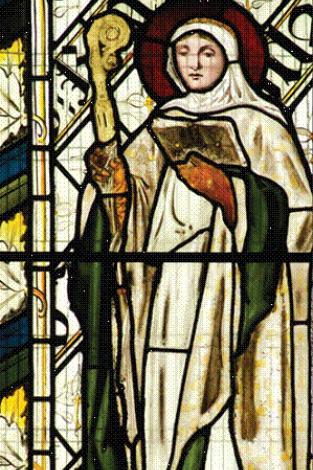|
Women deacons the solution to priestly power problem
By Phyllis Zagano
The American television series Madam Secretary follows US Secretary of State Elizabeth McCord (Téa Leoni) as she navigates the worlds of politics and world diplomacy. Would the Vatican have a woman Secretary of State? Could it? Not long ago, Vatican Secretary of State Cardinal Pietro Parolin suggested there is nothing inherently clerical about his job. Or is there? The Vatican's Secretary of State, one of the pope's principal advisors, must be a cardinal. And cardinals — at least since promulgation of the 1983 Code of Canon Law — must be at least priests. So that leaves half the church out of the running entirely. Women cannot be ordained priests. But there are three types of cardinals: cardinal bishops, cardinal priests, and cardinal deacons. And in modern times there have been cardinal deacons who indeed were deacons. And throughout history, women have been deacons. So, is there a chance? Is there any possibility the church will have a woman Secretary of State who is a cardinal deacon? The only barriers are what are known as 'merely ecclesiastical laws,' laws that regulate the running of the Catholic Church, but are not related to dogma or doctrine. In short, the laws that keep women from being cardinal deacons are laws until the pope decides to change them. The first step would be to return to the Church's earlier practice of ordaining women as deacons. Ordaining women as deacons would bring them into the clerical state, required to fulfil completely many church offices. The Church's canon laws state that the laity may 'cooperate with' but not 'share' authority in the church, and that applies to many positions. Restoring women to the ordained diaconate would allow them to hold wholly (the formal word is 'obtain') certain offices now restricted to clerics, such as chancellor and judge. "More than one pope has called for a 'more incisive' role for women in the church. None has managed to answer."The diaconate is a ministry of service, and deacons are ordained to ministry of the Word, the liturgy, and charity. But as the church has grown in bureaucratic complexity, so has grown the need for clerical status. And some deacons — males all — already serve in church offices that could be equally open to women if they, too, were ordained. But the complexity of the discussion is not only about whether women can be ordained. Some feminists argue against restoring women to the diaconate because they see it as a second-fiddle sop to quiet the evident and growing unrest among women (and many men) about the dearth of women in official church life. Some misogynists argue against restoring women to the diaconate because they see it as the camel's nose under the tent of priesthood and episcopacy, even as they pat women's heads and accept the voluntary self-funded ministries of hundreds of thousands of women religious. Yet attempting to appease everyone appeases no one. The Church knows full well it needs to find a way to incorporate more women into its hierarchical structures. More than one pope has called for a 'more incisive' role for women in the church. None has managed to answer his own call. What to do? In 2002, the International Theological Commission, a Vatican body connected to the Congregation for the Doctrine of the Faith, presented a long-awaited study document on the diaconate. Work on the paper began at least by 1992. Many reports state that in 1997 the Commission completed a positive report affirming the possibility of restoring women to the diaconate, but that the Congregation's prefect, Joseph Ratzinger, refused to sign it. In fact, in 1997, Ratzinger named a new committee, headed by one of his former graduate students, which eventually produced an inconclusive study document four times the size of the original. The newer document, first written in French and soon published in a still widely-circulated unofficial English translation, lately appears on the Vatican website in German, Hungarian, Italian, Polish, Portuguese, Russian and Spanish. The study document concludes that male and female deacons had different roles in the early church, that priesthood and the diaconate are separate and distinct ministries, and that the question of admitting women to the diaconate was something for the Church's 'ministry of discernment' to decide. Most scholars argue with the document's embedded implication that women cannot be restored to the one order of deacon. Among other things, they point to the fact that the Commission ignored or relegated to footnotes serious scholarship about women deacons by major scholars, including Philippe Delhaye, Roger Gryson, Corrado Marucci, Pietro Sorci and Cipriano Vagaggini, all well-known and well-published at the time. Rome has produced nothing about women deacons since. Pope Francis may be interested in better situating women within Church governance and ministry, and there is sufficient theological evidence to readmit women to the order of deacon. Even so, significant curial roadblocks keep him from moving in the obvious direction. Women deacons could take up significant posts, at the Vatican and around the world, but in 2008 the Congregation for the Doctrine of the Faith decreed ordination of women a crime worthy of automatic excommunication. Francis has decried priesthood's connection to power and authority as problematic, saying it 'presents a great challenge ... with regard to the possible role of women in decision-making in different areas of the Church's life'. But if priesthood is the problem, the diaconate is the solution. Where would the restoration of women to the diaconate lead? In the season finale of Madam Secretary, the president of the United States asked Secretary McCord if she would be his vice-presidential running mate in the coming year. Now, that would really be something to see in the Catholic Church.
|
.
Any original material on these pages is copyright © BishopAccountability.org 2004. Reproduce freely with attribution.
